Blog & Latest Updates
Fly Fishing Articles
Insects by Common Name


True Fly Family Chironomidae (Midges)
Taxonomic Navigation -?-
Kingdom
Animalia (Animals)
» Phylum
Arthropoda (Arthropods)
» Class
Insecta (Insects)
» Order
Diptera (True Flies)
» Family Chironomidae (Midges)
| Genus in Chironomidae | ||
| Chironomus | 0 | 0 |
| Prodiamesa | 0 | 0 |
| Rheotanytarsus | 0 | 0 |
| Stenochironomus | 0 | 0 |
| Stictochironomus | 0 | 0 |
194 genera aren't included.
Common Name
| Match | Common Name |
| Midges |
Some midges are large, up to hook size 14, but the majority are size 22 or smaller. The number of genera and species is hopelessly huge for angler entomologists to ever learn, and the identifing characteristics often require slide-mounting tiny parts under high-powered microscopes. Even the most Latin-minded fisherman must slip back to the basics--size and color--to describe his local midge hatches.
Where & When
Regions: East, Midwest, West
Time Of Year (?): All year
Preferred Waters: All water, but most relevant in lakes and slow rivers
Hatching Behavior
Midges rise to the surface as pupae and struggle slowly through the surface film while the pupa's body dangles vertically below. This is the most common stage for trout to take, though the adults may be useful at times too.
Midge pupae account for much of the mystifying midsummer spring creek action on evenings when no bugs seem to be in the air or on the water, yet trout are rising everywhere and ignoring one's flies. Recognizing a midge hatch is far from a guarantee of fish, however. Suitable imitation is not easy.
Larva & Pupa Biology
Substrate: Usually silt or detritus (Detritus: Small, loose pieces of decaying organic matter underwater.)
Environmental Tolerance: Best in clear water
Anglers in on very fertile rivers, especially lakes and western tailwater rivers, often do well by imitating midge larvae.Environmental Tolerance: Best in clear water
Chironomidae Fly Fishing Tips
Despite the tiny size of midges, trout can be very selective to their size and color. Remember that a difference of a single hook size in the tiny sizes is a very large percentage difference and very noticeable by the trout. Netting some of the real insects before choosing a fly is surely a good idea, but it's easier said than done.
Pictures of 25 Midge Specimens:
Male Stictochironomus Midge Adult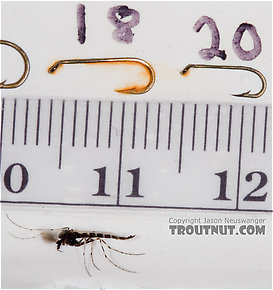 View 11 PicturesThis midge and several like it, including a female I also photographed, hatched from larvae which were living in some fine mud I'm using as substrate in my bug-rearing aquarium.
View 11 PicturesThis midge and several like it, including a female I also photographed, hatched from larvae which were living in some fine mud I'm using as substrate in my bug-rearing aquarium.
 View 11 PicturesThis midge and several like it, including a female I also photographed, hatched from larvae which were living in some fine mud I'm using as substrate in my bug-rearing aquarium.
View 11 PicturesThis midge and several like it, including a female I also photographed, hatched from larvae which were living in some fine mud I'm using as substrate in my bug-rearing aquarium.Collected April 10, 2007 from Mystery Creek #62 in New York
Added to Troutnut.com by Troutnut on April 10, 2007
Added to Troutnut.com by Troutnut on April 10, 2007
Female Chironomidae (Midges) Midge Adult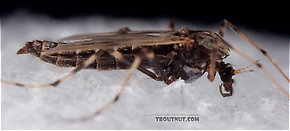 View 5 PicturesThis midge and several like it, including a male I also photographed, hatched from larvae which were living in some fine mud I'm using as substrate in my bug-rearing aquarium. This one flew away before I could photograph it on the ruler, but it would have measured slightly smaller than the male.
View 5 PicturesThis midge and several like it, including a male I also photographed, hatched from larvae which were living in some fine mud I'm using as substrate in my bug-rearing aquarium. This one flew away before I could photograph it on the ruler, but it would have measured slightly smaller than the male.
 View 5 PicturesThis midge and several like it, including a male I also photographed, hatched from larvae which were living in some fine mud I'm using as substrate in my bug-rearing aquarium. This one flew away before I could photograph it on the ruler, but it would have measured slightly smaller than the male.
View 5 PicturesThis midge and several like it, including a male I also photographed, hatched from larvae which were living in some fine mud I'm using as substrate in my bug-rearing aquarium. This one flew away before I could photograph it on the ruler, but it would have measured slightly smaller than the male.Collected April 10, 2007 from Mystery Creek #62 in New York
Added to Troutnut.com by Troutnut on April 10, 2007
Added to Troutnut.com by Troutnut on April 10, 2007
Rheotanytarsus Midge Larva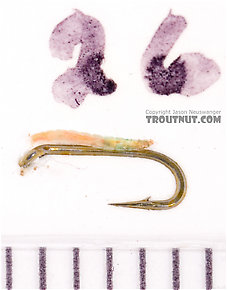 View 6 PicturesThis peculiar midge lived in a case tightly fixed to a rock, with several others of its kind. The case seems to be made of tiny grains of sand. I'm not sure what the function is for the little lines sticking out the front, because they aren't legs.
View 6 PicturesThis peculiar midge lived in a case tightly fixed to a rock, with several others of its kind. The case seems to be made of tiny grains of sand. I'm not sure what the function is for the little lines sticking out the front, because they aren't legs.
 View 6 PicturesThis peculiar midge lived in a case tightly fixed to a rock, with several others of its kind. The case seems to be made of tiny grains of sand. I'm not sure what the function is for the little lines sticking out the front, because they aren't legs.
View 6 PicturesThis peculiar midge lived in a case tightly fixed to a rock, with several others of its kind. The case seems to be made of tiny grains of sand. I'm not sure what the function is for the little lines sticking out the front, because they aren't legs.Collected April 14, 2007 from Cayuta Creek in New York
Added to Troutnut.com by Troutnut on April 22, 2007
Added to Troutnut.com by Troutnut on April 22, 2007
4 Underwater Pictures of Midges:
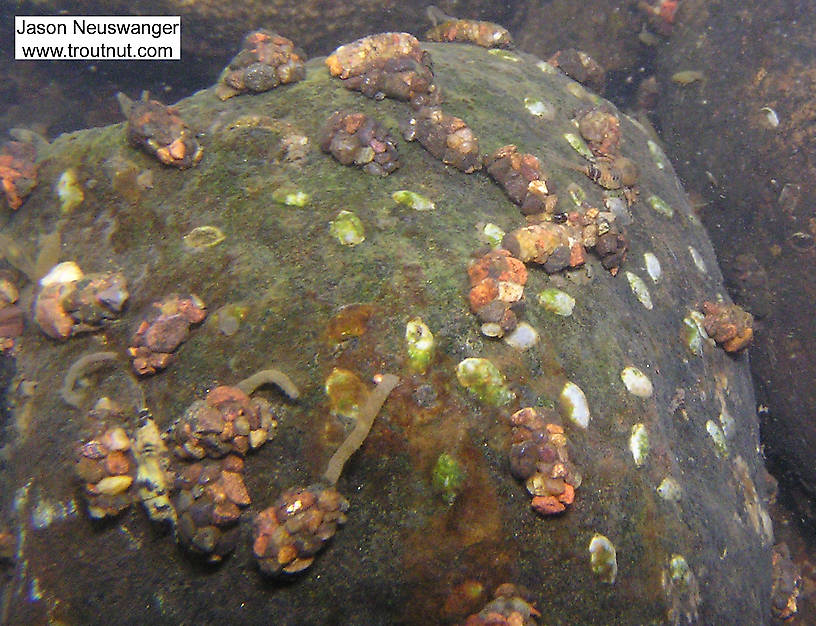
The white blotches on this rock are Leucotrichia caddisfly cases, and the wispy tubes are cases made by a type of midge.
In this picture: Mayfly Species Ephemerella invaria (Sulphur Dun), Caddisfly Species Leucotrichia pictipes (Ring Horn Microcaddis), and True Fly Family Chironomidae (Midges).
In this picture: Mayfly Species Ephemerella invaria (Sulphur Dun), Caddisfly Species Leucotrichia pictipes (Ring Horn Microcaddis), and True Fly Family Chironomidae (Midges).
StateWisconsin
LocationNamekagon River
Date TakenMar 24, 2004
Date AddedJan 25, 2006
AuthorTroutnut
CameraOlympus C740UZ
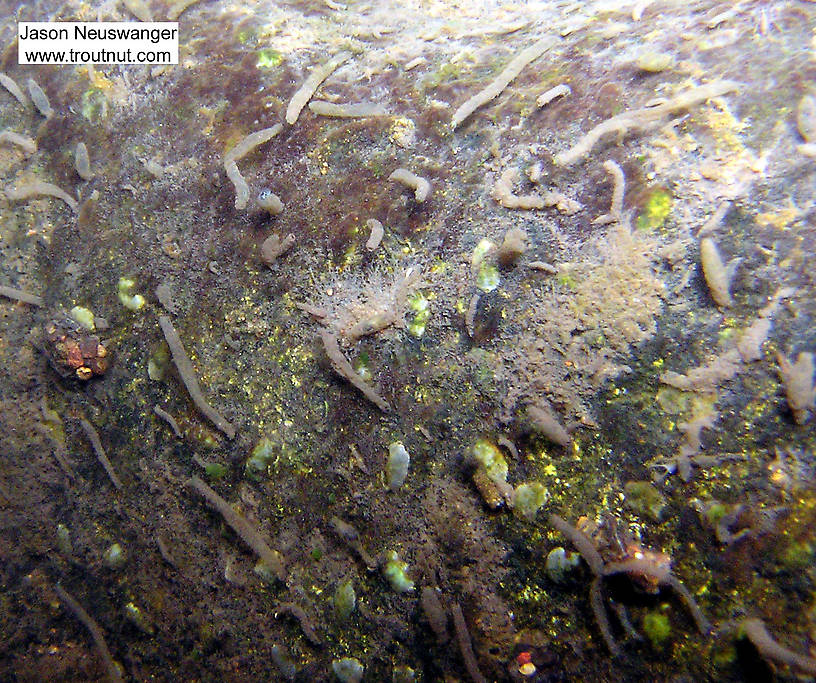
The strange tubes all over this rock house tiny midge larvae.
In this picture: Insect Order Trichoptera (Caddisflies), Insect Order Ephemeroptera (Mayflies), and True Fly Family Chironomidae (Midges).
In this picture: Insect Order Trichoptera (Caddisflies), Insect Order Ephemeroptera (Mayflies), and True Fly Family Chironomidae (Midges).
StateWisconsin
LocationNamekagon River
Date TakenMar 20, 2004
Date AddedJan 25, 2006
AuthorTroutnut
CameraOlympus C740UZ
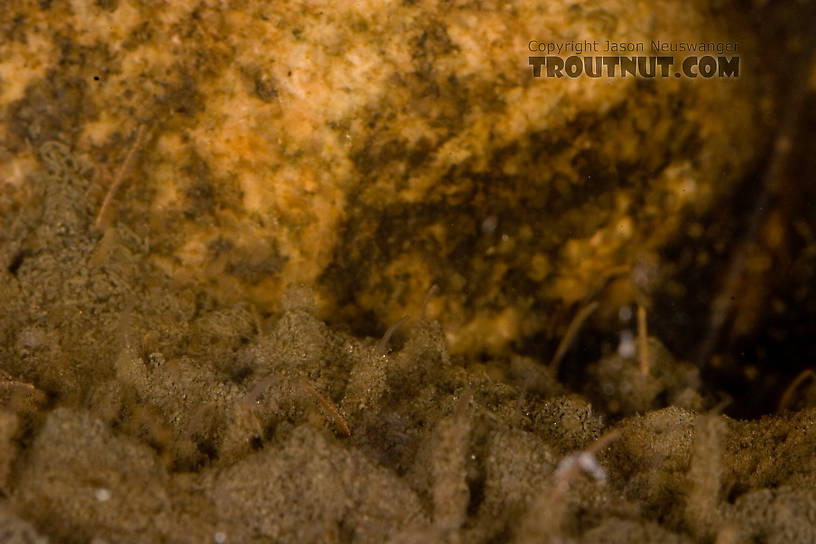
This isn't really an underwater picture, but a picture taken into my aquarium of midge larvae which lived in the silt I used for substrate. Each larva has a little tower of detritus (Detritus: Small, loose pieces of decaying organic matter underwater.) built up along the bottom, while the bare larva waves around from the top.
In this picture: True Fly Family Chironomidae (Midges).
In this picture: True Fly Family Chironomidae (Midges).
Recent Discussions of Chironomidae
getting midges down 9 Replies »
says here midge pupae rise in the water and struggle in the film to become adults. my imitations are so small that they don't seem to go down very far in order to rise--ike a wet fly might at the end of the swing. any ideas? or am i fishing them wrong?
ReplyClusters of midges and the Griffith's Gnat 35 Replies »This is a spin-off from a tangent in another topic which seems worthy of its own thread.
I wrote about the midge I photographed:
Gonzo replied:
Those are the explanations I've heard, too, but I'm skeptical of both. I'm not doubting the effectiveness of the Griffith's Gnat; I just think people have traditionally stretched the bounds of credibility when trying to explain a fly's success in imitative terms, and this is one of the more prominent examples.
Has anybody here seen a cluster of midges on the water? I haven't. I have seen midges thickly grouped on rocks next to the water, and I don't doubt that they occasionally fall off of there, and probably sometimes two are three are clinging to each other. I've also seen early-season stoneflies balled up with each other in an opaque little (presumably mating-related) clump on a midstream boulder, and I wouldn't be surprised if some midge species do something like that too. But trout don't see balls of midges floating around very often on any stream I've ever observed. Has anyone experienced that?
In either case, I can't see something so opaque as a Griffith's Gnat effectively imitating what would surely be a loose ball of gangly entangled midges. You would have to roll them around in your fingers for a while to goo them together so solidly.
I just can't see the herl and hackle imitating, or even suggesting, a loosening pupal shuck. Shucks don't get that loose. They trail behind length-wise; they don't balloon to the sides. And they aren't pointy. Of course I'm sure Schwiebert knows all that and was just trying to add an idea to the mix of explanations, but I do find that one as far-fetched as the others.
Here's another far-fetched guess: maybe the hackle and refractive trickery in the surface film reduce the perceived thickness of the fly and it passes for a single midge pretty well. This could be tested in an aquarium but it's late and I'm feeling lazy.
I think it's more likely that when trout take a Griffith's Gnat they're only looking for (at most) the right general size and color. It's not as fun, but sometimes things are really that simple.
ReplyMidges 10 Replies »I wrote about the midge I photographed:
I'm not sure how a griffith's gnat is supposed to imitate such a thing
Gonzo replied:
Schwiebert's theory was that when it was awash in the film, the herl and halo of hackle suggested the loosening pupal shuck around the dark body of the emerging midge. Others have speculated that it imitates a cluster of midges. Both theories are reasonable, I suppose, depending on the size of the Griffith's Gnat that is effective relative to the size of the actual midge. Like many anglers, I just know that it does work. :)
Those are the explanations I've heard, too, but I'm skeptical of both. I'm not doubting the effectiveness of the Griffith's Gnat; I just think people have traditionally stretched the bounds of credibility when trying to explain a fly's success in imitative terms, and this is one of the more prominent examples.
Has anybody here seen a cluster of midges on the water? I haven't. I have seen midges thickly grouped on rocks next to the water, and I don't doubt that they occasionally fall off of there, and probably sometimes two are three are clinging to each other. I've also seen early-season stoneflies balled up with each other in an opaque little (presumably mating-related) clump on a midstream boulder, and I wouldn't be surprised if some midge species do something like that too. But trout don't see balls of midges floating around very often on any stream I've ever observed. Has anyone experienced that?
In either case, I can't see something so opaque as a Griffith's Gnat effectively imitating what would surely be a loose ball of gangly entangled midges. You would have to roll them around in your fingers for a while to goo them together so solidly.
I just can't see the herl and hackle imitating, or even suggesting, a loosening pupal shuck. Shucks don't get that loose. They trail behind length-wise; they don't balloon to the sides. And they aren't pointy. Of course I'm sure Schwiebert knows all that and was just trying to add an idea to the mix of explanations, but I do find that one as far-fetched as the others.
Here's another far-fetched guess: maybe the hackle and refractive trickery in the surface film reduce the perceived thickness of the fly and it passes for a single midge pretty well. This could be tested in an aquarium but it's late and I'm feeling lazy.
I think it's more likely that when trout take a Griffith's Gnat they're only looking for (at most) the right general size and color. It's not as fun, but sometimes things are really that simple.
Hi Jason & Gonzo! I did well over the weekend by fishing some midge pupa imitations as nymphs and in the film. Where does one find midge larva to inspect for pattern imitation? I fished the pupas and larvas on 5x tippet and it seemed to work well. Do midges live in the silt or on the bottom of rocks, etc.? I have the book by Ed Koch and ?, the other name escapes me for the moment, but it doesn't exactly say where they are found. Midges are about the game in in town during the winter months so I thought I'd learn a little about them. Thanks
ReplyLife cycles and hatches 3 Replies »Posted by Leahdanger on Mar 7, 2014
Last reply on Mar 9, 2014 by Entoman
Hi,
I am trying to identify the life cycle of a few aquatic insects in eastern British Columbia. Specifically, I want to know if the species I collected in the fall (Aug-Oct) are a different hatch from the species I collected in the spring (April-May). Does anybody know when the following species lay eggs, die, and hatch: amphipods (Hyalella aztecha), chironomids, leeches, mayflies (Leptophlebiidae paraleptophlebia, Baetida sp.), and caddis flies (Oxyethira sp., Hydropsychidae arctopsyche)? For my purposes, knowing the general life cycle of amphipods and chironomids would be great.
Thanks much for your help!
Leah
ReplyMidge Video 5 Replies »I am trying to identify the life cycle of a few aquatic insects in eastern British Columbia. Specifically, I want to know if the species I collected in the fall (Aug-Oct) are a different hatch from the species I collected in the spring (April-May). Does anybody know when the following species lay eggs, die, and hatch: amphipods (Hyalella aztecha), chironomids, leeches, mayflies (Leptophlebiidae paraleptophlebia, Baetida sp.), and caddis flies (Oxyethira sp., Hydropsychidae arctopsyche)? For my purposes, knowing the general life cycle of amphipods and chironomids would be great.
Thanks much for your help!
Leah
I thing some members will like this video on midges.
http://www.midcurrent.com/video/clips/cutter_midge.aspx
Best
JAD
Replyhttp://www.midcurrent.com/video/clips/cutter_midge.aspx
Best
JAD
There are 4 more topics.
Your Thoughts On Chironomidae:
Top 10 Fly Hatches
Top Gift Shop Designs
Eat mayflies.
Top Insect Specimens
Miscellaneous Sites
Troutnut.com is copyright © 2004-2024 Jason
Neuswanger (email Jason). See my FAQ for information about use of my images.
 privacy policy
privacy policy
